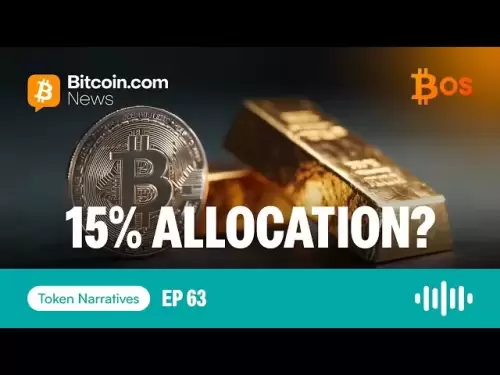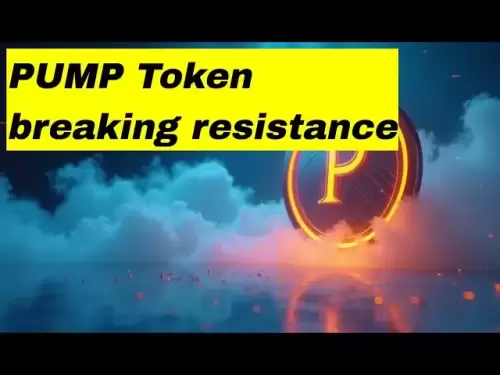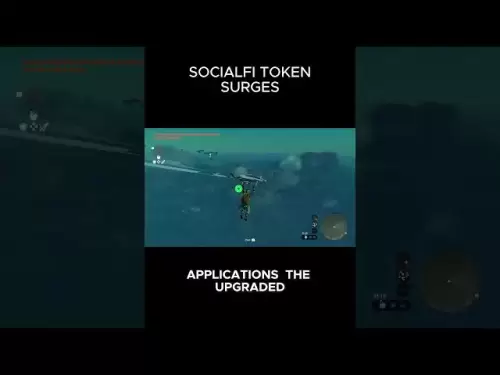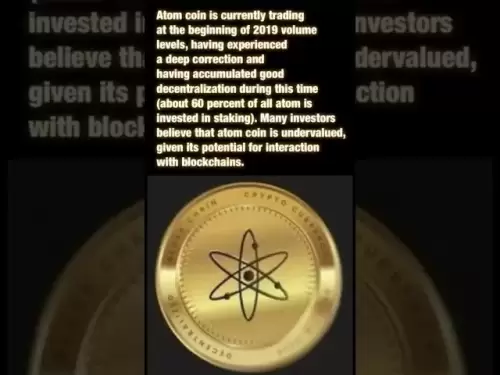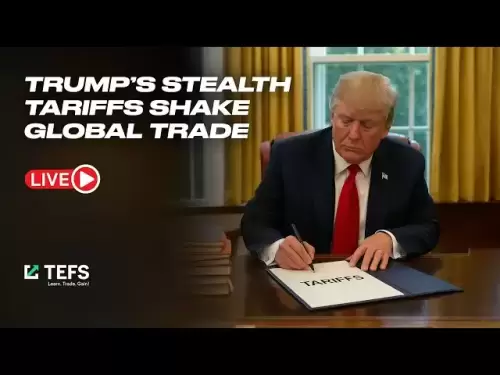-
 Bitcoin
Bitcoin $115200
-2.68% -
 Ethereum
Ethereum $3601
-5.16% -
 XRP
XRP $3.035
-2.96% -
 Tether USDt
Tether USDt $0.9997
-0.04% -
 BNB
BNB $764.5
-5.43% -
 Solana
Solana $168.1
-5.92% -
 USDC
USDC $0.9998
-0.02% -
 Dogecoin
Dogecoin $0.2090
-4.80% -
 TRON
TRON $0.3272
-0.49% -
 Cardano
Cardano $0.7306
-5.00% -
 Hyperliquid
Hyperliquid $39.16
-12.22% -
 Stellar
Stellar $0.3967
-4.96% -
 Sui
Sui $3.566
-5.95% -
 Chainlink
Chainlink $16.55
-6.57% -
 Bitcoin Cash
Bitcoin Cash $552.3
-3.90% -
 Hedera
Hedera $0.2516
-4.69% -
 Avalanche
Avalanche $21.99
-5.75% -
 Toncoin
Toncoin $3.621
-0.28% -
 Ethena USDe
Ethena USDe $1.000
-0.03% -
 UNUS SED LEO
UNUS SED LEO $8.951
0.02% -
 Litecoin
Litecoin $105.9
-3.59% -
 Shiba Inu
Shiba Inu $0.00001232
-5.00% -
 Polkadot
Polkadot $3.640
-5.55% -
 Uniswap
Uniswap $9.048
-7.03% -
 Monero
Monero $301.8
-1.51% -
 Dai
Dai $0.9999
-0.01% -
 Bitget Token
Bitget Token $4.334
-3.66% -
 Pepe
Pepe $0.00001064
-6.17% -
 Cronos
Cronos $0.1367
-5.78% -
 Aave
Aave $259.2
-4.59%
How to protect NFT copyrights? How to deal with infringements?
To protect NFT copyrights, register your work, use watermarks, and include smart contract clauses; if infringed, gather evidence, contact the infringer, and report to platforms.
May 16, 2025 at 03:36 pm
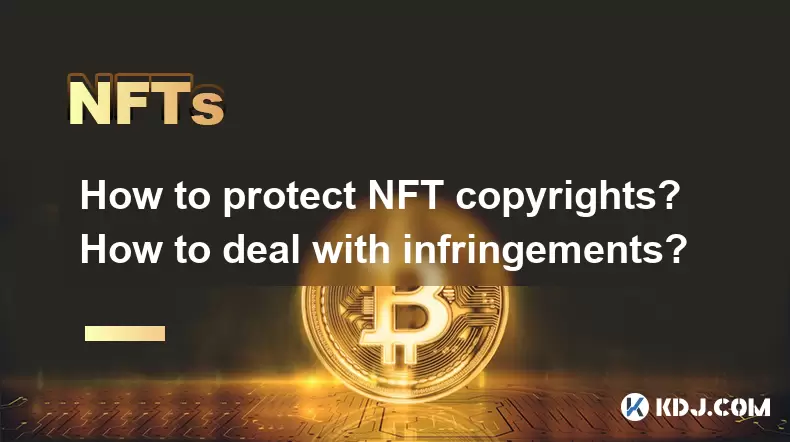
How to Protect NFT Copyrights? How to Deal with Infringements?
Non-fungible tokens (NFTs) have revolutionized the way digital art and collectibles are bought, sold, and owned. However, with the rise in popularity of NFTs, issues surrounding copyright protection and infringement have become increasingly prevalent. This article will guide you through the steps to protect your NFT copyrights and how to deal with infringements effectively.
Understanding NFT Copyrights
NFTs are unique digital assets stored on a blockchain, often representing ownership of digital art, music, videos, or other forms of creative works. The ownership of an NFT does not necessarily equate to owning the copyright of the underlying asset. Copyright refers to the legal right granted to the creator of an original work, giving them exclusive rights to use, reproduce, and distribute the work.
To protect your NFT copyrights, it is crucial to understand that while the NFT itself is a token of ownership, the copyright of the artwork or asset remains with the creator unless explicitly transferred. Therefore, when minting an NFT, creators should ensure that the terms of sale clearly state whether the copyright is included or retained.
Steps to Protect Your NFT Copyrights
Protecting your NFT copyrights involves several proactive measures. Here are some steps you can take:
Register Your Copyright: While copyright automatically applies to original works upon creation, registering your work with the U.S. Copyright Office or equivalent in your jurisdiction provides additional legal protection. This step can be crucial in proving ownership and seeking damages in case of infringement.
Use Watermarks: Adding a visible watermark to your digital assets can deter potential infringers. Watermarks should be subtle enough not to detract from the artwork but visible enough to serve as a deterrent.
Smart Contract Clauses: When minting an NFT, you can include clauses in the smart contract that specify the terms of use for the asset. This can include restrictions on reproduction, distribution, and commercial use.
License Agreements: Consider using license agreements to outline the rights granted to the buyer. This can help clarify what the buyer can and cannot do with the NFT and the underlying asset.
Monitor Online Platforms: Regularly monitor online marketplaces and social media platforms for unauthorized use of your work. Tools like Google Alerts can help you keep track of where your work appears online.
Dealing with NFT Infringements
Despite your best efforts to protect your NFT copyrights, infringements can still occur. Here’s how you can deal with them effectively:
Identify the Infringement: First, gather evidence of the infringement. This includes screenshots, URLs, and any other relevant information that proves the unauthorized use of your work.
Contact the Infringer: In some cases, the infringement may be unintentional. Sending a polite but firm cease and desist letter can often resolve the issue without further action. The letter should clearly state your ownership, the nature of the infringement, and demand that the infringer stop using your work immediately.
Report to Platforms: Most NFT marketplaces and social media platforms have mechanisms for reporting copyright infringements. Use these tools to notify the platform of the unauthorized use of your work. Platforms like OpenSea and Rarible have specific forms for reporting copyright issues.
Legal Action: If the infringer does not comply with your cease and desist letter, you may need to take legal action. This can involve filing a lawsuit for copyright infringement. Consult with a lawyer specializing in intellectual property to understand your options and the potential outcomes.
Preventing Future Infringements
To minimize the risk of future infringements, consider implementing the following strategies:
Educate Your Community: Use social media and other platforms to educate your followers about the importance of respecting copyrights. Encourage them to report any unauthorized use of your work that they come across.
Regularly Update Your Contracts: As the NFT landscape evolves, so should your smart contracts and license agreements. Regularly review and update these documents to ensure they reflect current best practices and legal standards.
Collaborate with Other Creators: Building a network of creators who support each other can be invaluable. Share experiences and strategies for protecting your work, and collaborate on initiatives to promote copyright awareness within the NFT community.
Utilizing Blockchain Technology
Blockchain technology offers unique opportunities for protecting NFT copyrights. By leveraging the immutable nature of blockchain, creators can timestamp their work and prove ownership. Platforms like Binance Smart Chain and Ethereum allow creators to mint NFTs with embedded metadata that can include copyright information.
Timestamp Your Work: Use blockchain platforms to timestamp your work. This creates a verifiable record of when the work was created and by whom, which can be crucial in proving ownership.
Embed Metadata: When minting an NFT, include metadata that clearly states the copyright holder and any terms of use. This information is stored on the blockchain and can be referenced in case of disputes.
Use Decentralized Platforms: Decentralized platforms can offer more control over your NFTs and the underlying assets. Platforms like Arweave and IPFS allow you to store your work in a decentralized manner, reducing the risk of centralized control and potential infringement.
FAQs
Q: Can I copyright an NFT itself?
A: No, an NFT itself cannot be copyrighted as it is a token representing ownership of an asset. However, the underlying asset (e.g., digital art) can be copyrighted.
Q: What should I do if I suspect someone is selling counterfeit NFTs of my work?
A: Gather evidence of the counterfeit NFTs and report them to the platform where they are being sold. If the platform does not take action, consider sending a cease and desist letter to the seller and consult with a lawyer if necessary.
Q: How can I prove ownership of an NFT if someone else claims it as theirs?
A: Use the blockchain record to prove ownership. The transaction history on the blockchain can show when and by whom the NFT was minted and transferred. Additionally, if you have registered your copyright, this can further support your claim.
Q: Are there any tools specifically designed for tracking NFT copyright infringements?
A: Yes, several tools can help track NFT copyright infringements. Platforms like NFTScan and NFTBounty offer services to monitor the use of your NFTs across various marketplaces and alert you to potential infringements.
Disclaimer:info@kdj.com
The information provided is not trading advice. kdj.com does not assume any responsibility for any investments made based on the information provided in this article. Cryptocurrencies are highly volatile and it is highly recommended that you invest with caution after thorough research!
If you believe that the content used on this website infringes your copyright, please contact us immediately (info@kdj.com) and we will delete it promptly.
- Dogecoin's Price Support Under Fire: Can It Fend Off Competitors?
- 2025-08-02 04:30:12
- AI Cloud Mining: How AIXA Miners is Empowering Young Investors
- 2025-08-02 04:30:12
- Crypto Spotlight: Rollblock's Rise, Ripple's Resistance, and What It Means for Your Portfolio
- 2025-08-02 04:50:12
- Crypto's Golden Age: Tether Gold, Institutional BTC, and the Future of Finance
- 2025-08-02 04:50:12
- VeChain, Unilabs, XRP: Decoding August's Crypto Moves
- 2025-08-02 04:55:43
- Bitcoin, Whales, and Profit: Decoding Crypto's Latest Moves
- 2025-08-02 04:55:43
Related knowledge

Is it possible to get a refund on an NFT?
Jul 21,2025 at 08:35pm
Understanding NFT Transactions and RefundsWhen you purchase an NFT (Non-Fungible Token), the transaction is typically recorded on a blockchain, making...

What happens to NFTs when the owner dies?
Jul 22,2025 at 02:43pm
Legal Ownership and Digital AssetsWhen an individual owns NFTs, the question of what happens to these assets upon their death is a pressing one. NFTs ...

What are the tax implications of gifting an NFT?
Jul 19,2025 at 04:21am
Understanding the Basics of NFT GiftingGifting a Non-Fungible Token (NFT) involves transferring ownership from one individual to another without recei...

Can you trade NFTs on your phone?
Jul 18,2025 at 04:29am
Trading NFTs on Mobile DevicesYes, you can trade NFTs on your phone, and the process has become increasingly streamlined thanks to a variety of mobile...

How to find out about upcoming NFT mints?
Jul 18,2025 at 11:50am
Exploring NFT Minting OpportunitiesUnderstanding the landscape of upcoming NFT mints is crucial for collectors, investors, and creators who wish to st...

What is an allowlist or whitelist for an NFT mint?
Jul 20,2025 at 07:14pm
Understanding the Concept of an Allowlist for NFT MintingAn allowlist, also commonly referred to as a whitelist, is a mechanism used in the NFT mintin...

Is it possible to get a refund on an NFT?
Jul 21,2025 at 08:35pm
Understanding NFT Transactions and RefundsWhen you purchase an NFT (Non-Fungible Token), the transaction is typically recorded on a blockchain, making...

What happens to NFTs when the owner dies?
Jul 22,2025 at 02:43pm
Legal Ownership and Digital AssetsWhen an individual owns NFTs, the question of what happens to these assets upon their death is a pressing one. NFTs ...

What are the tax implications of gifting an NFT?
Jul 19,2025 at 04:21am
Understanding the Basics of NFT GiftingGifting a Non-Fungible Token (NFT) involves transferring ownership from one individual to another without recei...

Can you trade NFTs on your phone?
Jul 18,2025 at 04:29am
Trading NFTs on Mobile DevicesYes, you can trade NFTs on your phone, and the process has become increasingly streamlined thanks to a variety of mobile...

How to find out about upcoming NFT mints?
Jul 18,2025 at 11:50am
Exploring NFT Minting OpportunitiesUnderstanding the landscape of upcoming NFT mints is crucial for collectors, investors, and creators who wish to st...

What is an allowlist or whitelist for an NFT mint?
Jul 20,2025 at 07:14pm
Understanding the Concept of an Allowlist for NFT MintingAn allowlist, also commonly referred to as a whitelist, is a mechanism used in the NFT mintin...
See all articles





















